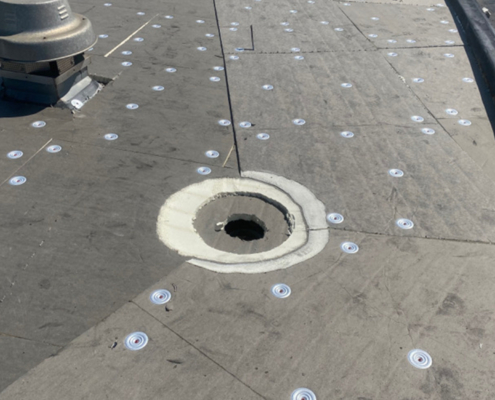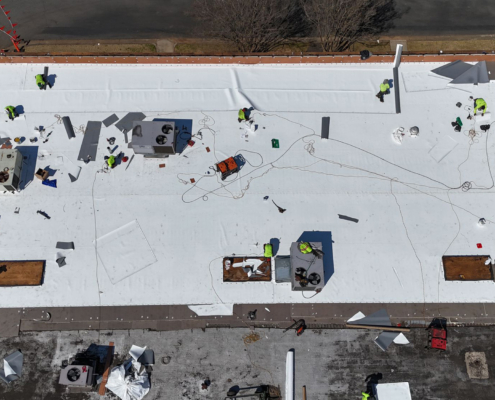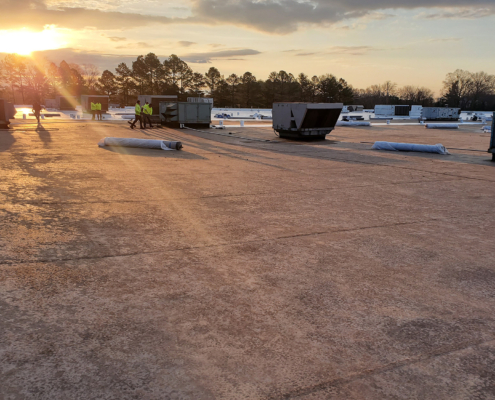How Often Should a Commercial Roof Be Inspected?
Roof inspection frequency should include inspections twice a year, typically in the spring and fall. This is when your roof is most vulnerable: recovering from or preparing for extreme weather. However, depending on your region, roof type, and recent weather events, more frequent checks may be needed. Skipping seasonal roof inspections can create issues that slowly build up over time. By the time they’re visible inside your building, you may already be looking at expensive repairs.
Spring Roof Inspections: Recovering from Winter
Winter can be brutal on commercial roofs. Heavy snow, ice dams, and freezing temperatures often leave behind hidden damage. That’s why spring is one of the most important times to inspect your roof.
Here’s what to look for:
- Ice damage: Cracks and splits in the membrane or seams
- Ponding water: Poor drainage from melting snow
- Clogged gutters or downspouts: Ice buildup can lead to water overflow
- Loose flashing or fasteners: Caused by temperature changes and snow pressure
A spring inspection helps you catch and fix these problems early, before heavy spring rains arrive. Professional roofing contractors will also check for any storm-related wear from the previous winter, ensuring your roof is ready for the next season.
Summer Roof Inspections: Fighting UV Rays and Heat Stress
Many people think summer is the least threatening season for roofs—but high temperatures and UV radiation can be just as damaging. Materials like TPO, PVC, and modified bitumen expand in the heat, and without regular maintenance, that can lead to cracks or bubbling.
Include the following in your summer inspection checklist:
- UV damage: Fading or brittleness in roofing materials
- Cracking seams: From heat expansion and contraction
- Signs of water infiltration: After summer storms
- Ventilation issues: Improper airflow can trap heat inside the building
This is also a great time to review your roof’s waterproofing. A professional can check seals, inspect skylights, and test the integrity of your roof’s drainage system. Heat damage builds slowly, so summer roof inspections help you stop issues before they develop further.
Fall Roof Inspections: Prepping for Storms and Cold Weather
Fall is another essential time to schedule a professional roof inspection. As trees lose their leaves and temperatures begin to drop, your building prepares for another round of harsh conditions. If fall maintenance is skipped, problems will only get worse when winter hits.
A fall inspection should include:
- Clearing debris from gutters and drains: Leaves can cause major blockages
- Reinforcing weak areas: Sealing cracks and checking for punctures
- Inspecting insulation: Make sure your building stays energy-efficient
- Checking flashings and roof edges: Wind can lift poorly secured areas
Wind is one of the worst offenders when it comes to roof damage. Gusts can lift membranes or blow off flashing if your roof isn’t properly secured. Plus, falling branches and debris during storms can cause serious punctures. Staying on top of fall roof maintenance is key to staying dry and safe all winter.
Winter Roof Inspections: Keeping Weight and Water in Check
While winter inspections can be more difficult due to weather conditions, they’re still important, especially after major snowstorms or freezing rain. The weight of snow, the formation of ice dams, and freeze-thaw cycles can all stress your roof.
Winter inspection points include:
- Snow load checks: Make sure your roof can handle the weight
- Inspecting for ice dams: Look for areas where melting snow refreezes
- Checking for active leaks: Especially near vents and skylights
- Monitoring drainage systems: To prevent backflow or overflow
Having your roof checked after a big storm is one of the smartest ways to prevent costly emergencies and increase your roof inspection frequency. If you spot any sagging areas or visible damage, call a professional immediately.






